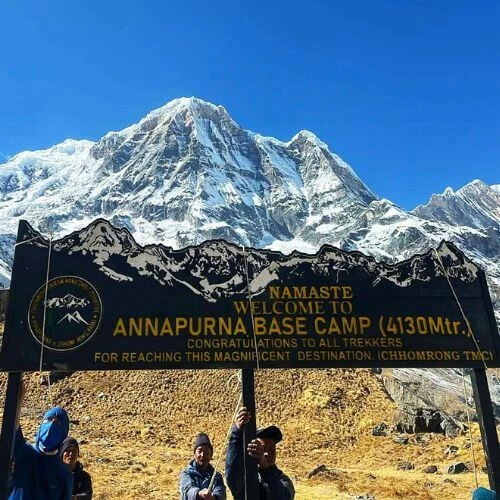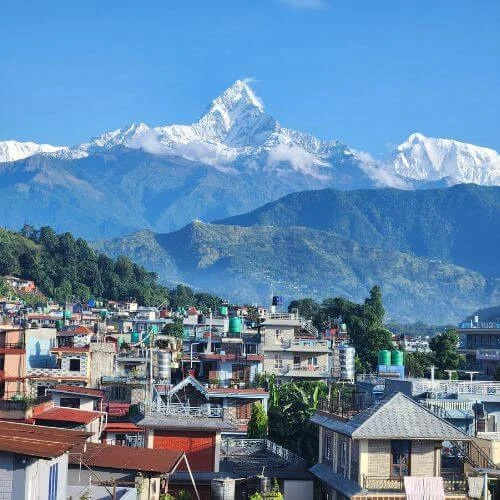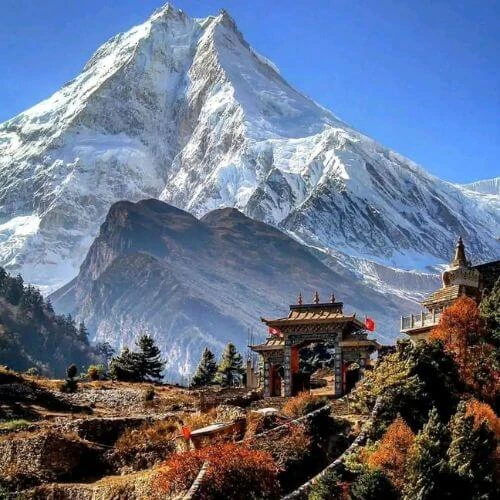In Kathmandu, Nepal, the Ghode Jatra, an annual festival, showcases the rich cultural heritage of the Newar community. This ancient festival, also known as the Ghore Jatra, holds immense significance in the culture of the Kathmandu Valley, attracting thousands of locals and visitors alike to take part in the grand celebrations.
The festival's name, "Ghode Jatra," signifies "Horse Procession," accurately portraying the central event – a grand parade featuring beautifully decorated horses. However, the festival's origins delve deeper into Newar culture, involving legends and stories that hold significant importance to the community. The parade serves as a means of portraying these ancient tales, which are integral to Newar beliefs and traditions.
According to ancient Hindu stories, the Ghode Jatra festival celebrates the victory of the important Hindu god, Lord Bhairav, over a terrifying demon named Ghanta Karna. This evil demon had been causing great trouble and fear for the people living in the Kathmandu Valley, but Lord Bhairav bravely fought and defeated him. The procession of horses symbolizes Lord Bhairav's triumphant return to the valley after winning the battle, representing the victory of good over evil.
This festival in Nepal lasts for several days and captivates everyone with its amazing sights. The most exciting part is the grand parade that unfolds on the streets of Kathmandu. In this parade, organizers decorate horses with fancy costumes, jewelry, and decorations, creating a vibrant and lively show. Traditional music and dancing accompany the parade, with the sound of drums and other instruments filling the air, evoking an atmosphere reminiscent of the past. Dancers dressed in bright and colorful clothes perform special dance moves, adding to the liveliness and excitement of the event.

During Ghode Jatra, one of the most special moments occurs when the Kumari, believed to be a living goddess, and the deity Lord Bhairav embark on a chariot ride. The Kumari, a young girl seen as the embodiment of divine female energy, rides through the streets on a beautiful chariot, accompanied by Lord Bhairav. Witnessing this procession is a profound and awe-inspiring experience.
Beyond its religious and cultural significance, the Ghode Jatra provides a platform for local artisans to preserve and promote traditional arts and crafts. Local artisans showcase their skills in creating intricate masks, costumes, and decorations, enhancing the festival's magnificence and ensuring the transmission of age-old traditions to future generations.
The Ghode Jatra truly celebrates the unity and diversity within the Newar community. People from different castes and backgrounds join together to participate in the festivities, fostering a sense of harmony and companionship. It is a time for family gatherings, feasting, and reveling in the rich cultural heritage that defines the essence of the Kathmandu Valley.
When is Ghode Jatra Celebrated?
This year Ghodejatra in Nepal will be celebrated on Chaitra 04, 2082, corresponding to March 18, 2026, in the Gregorian calendar. The festival marks the beginning of the Nepalese New Year and involves a grand procession of beautifully decorated horses and people in colorful attire parade through the streets of central Kathmandu, including places like Kathmandu Durbar Square and Tundikhel. It commemorates the day when a statue of Lord Vishnu was taken out of the valley for its renewal. During the festival, parade displays showcase cavalry and military performances, and traditional sports like horse racing and mask dances are also part of the celebrations.
How is Ghode Jatra celebrated?
In Nepal, Ghodejatra is celebrated grandly and vibrantly, especially in Kathmandu's Tudikhel, and in other parts of Nepal, including Lalitpur, Bhaktapur, Palpa, Butwal, and Dharan. The festival features a huge parade in central Kathmandu, where beautifully decorated horses and people dressed in colorful traditional attire take part. This festival in Kathmandu showcases the vibrant culture of the region. The parade includes impressive displays by cavalry units from the Nepalese Army, showcasing equestrian skills and horsemanship through various performances and formations. Traditional horse racing events are also organized, with riders competing on designated tracks.

The festival holds strong cultural and religious significance. Various cultural troupes perform mask dances, where dancers adorned with intricate masks portray stories and folklore through choreographed moves. Smaller parades highlight different cultural aspects of Nepal, including traditional music, dances, and costumes. The festival also marks the renewal of a Vishnu statue, with Hindu priests conducting rituals and pujas (worship ceremonies) during the celebrations.
Throughout the day, an atmosphere of festivities prevails, with people enjoying traditional Nepalese delicacies, music, and cultural programs organized across the city.
Facts about ghode Jatra
- This Nepali horse festival is thought to have started in ancient times, specifically during Nepal's Licchavi period, which spanned the 4th to 9th century.
- The Newar community originated this festival, but everyone in and around the Kathmandu Valley observes it.
- People celebrate the festival on the new moon of Chaitra Sukla Pakshya, typically falling in mid-March or early April.
- The festival is associated with the mythology of the defeat of Tundi, a demon that was said to haunt the Kathmandu Valley. The celebration honors the city's defense against him as well as its defeat.
- Ghode Jatra's main attraction is a magnificent parade of exquisitely painted horses that parade through Kathmandu's streets
- According to Hindu belief, horses are paraded in Tundikhel to "gallop over the grave of the defeated demon Tundi to keep him underground."
- In addition to the grand horse parade in Kathmandu, Ghode Jatra also includes traditional horse racing events, where skilled riders compete in designated tracks.
- The festival's spiritual and cultural significance is increased when the Kumari, a young girl worshipped as a living goddess, takes part in the procession during Ghode Jatra.

Legends and Myths Behind the Celebration of Ghode Jatra
The history of the Ghode Jatra festival has its roots in various legends and mythological stories passed down through generations in Nepal. One prominent legend associated with the festival's origin dates back to the ancient Lichchhavi period when powerful kings ruled the Kathmandu Valley. According to this legend, a severe drought once afflicted the valley, causing immense hardship. Advised by priests, the king decided to bring a statue of the Hindu god Vishnu from India, believing it would appease the deities and end the drought. The sacred Vishnu statue was then brought into the valley as part of a grand procession led by soldiers on horseback. It is said that upon the arrival of this procession, the rain finally arrived, providing relief to the parched lands and people. This mythological tale of the horse-led procession with the Vishnu statue is widely believed to be the origin of the vibrant Ghode Jatra festival celebrated in Kathmandu to this day.

Another legend about Ghode Jatra dates back to the Malla dynasty rulers who reigned between the 12th and 18th centuries. According to legend, the king had a vision of a demon named Tundi, believed to be responsible for killing children in Kathmandu. To counter this threat, the king commissioned the construction of a horse stable and organized a horse race festival. Celebrated on the new moon day in March/April, the festival aimed to honor the demon Tundi and safeguard children from harm. Additionally, it served to pay homage to the Hindu goddess Taleju Bhawani. Over time, the festival evolved into a grand cultural celebration featuring colorful processions of decorated horses, equestrian displays, mask dances, and rituals—all stemming from the original myth of vanquishing the evil demon Tundi.
Over time, Nepal's cultural celebration, Ghode Jatra, has evolved into an important event, symbolizing the victory of good over evil and the renewal of life and prosperity. Additionally, the festival acknowledges the significant role played by horses in Nepal's history, especially in warfare and transportation. This acknowledgment is why decorated horses and equestrian events like horse racing have become central to Ghode Jatra festivities. Alongside, various cultural traditions such as mask dances, parades, and rituals have been incorporated over the centuries, enriching Ghode Jatra as a grand festival that actively celebrates Nepal's diverse cultural heritage, religions, and the historical significance of horses.
Significance of Ghode Jatra
In Nepal's culture and religion, the Ghode Jatra festival holds great importance. It is rooted in ancient Hindu stories and traditions that Nepalese people have followed for hundreds of years. The festival actively celebrates the victory of good over evil and marks the beginning of new life, all while paying tribute to Nepal's longstanding history with horses. Ghode Jatra also serves as a means of preserving Nepal's old socio-cultural traditions, including the arts and crafts associated with the festival. By bringing together all Nepalese people, the festival fosters a sense of unity and pride in our heritage. Moreover, it actively maintains a rich cultural identity, effectively bridging the past with the present and future.

Religious and cultural significance
Ghode Jatra holds great religious and cultural significance in Nepal. Originating from Hindu mythology, it symbolizes the victory of good over evil, with rituals linked to deities like Lord Vishnu and Goddess Taleju Bhawani. Additionally, the festival honors Nepal's equine heritage, acknowledging the historical importance of horses. Ghode Jatra actively preserves cultural traditions through colorful processions, dances, and music, fostering a sense of pride among Nepalese people. Furthermore, it promotes community bonding by bringing together people from diverse backgrounds. Participants believe that Ghode Jatra brings blessings and good fortune to themselves and their families.
Symbol of National Unity
Ghode Jatra is celebrated by both Hindus and Buddhists in Nepal and actively symbolizes national unity. Originating from the ancient Licchavi period to honor a military triumph, it unites people from all regions to engage in vibrant cultural showcases of traditional decorations, dances, and music. This collective celebration of Nepal's rich heritage instills a profound sense of pride and fosters a unified national identity that transcends religious and cultural differences. Moreover, the festival attracts tourists worldwide, showcasing Nepal's unity through its diverse cultural traditions.

Preservation of Traditions
Ghode Jatra plays a crucial role in preserving traditions. This centuries-old festival allows for the passing down of age-old practices, rituals, dances, and cultural elements from one generation to the next. By showcasing traditional decorations, performances, and customs, it helps maintain a rich cultural identity and heritage. The vibrant celebrations cultivate a sense of pride in the Nepalese people for their unique traditions, encouraging further preservation. Ghode Jatra serves as a platform for the older generation to share knowledge and skills with the younger generation, ensuring continuity. Moreover, it brings together diverse communities, strengthening bonds and reinforcing the importance of upholding cultural traditions. Through its annual celebration, Ghode Jatra actively keeps Nepal's age-old traditions alive, fosters cultural identity and pride, facilitates knowledge transfer, and strengthens community unity – all contributing to the preservation of this rich Nepalese cultural festival.
Transmission of Cultural Values
Ghode Jatra, deeply rooted in Nepalese cultural beliefs and traditions, actively reinforces the sense of identity and appreciation for one's roots among the Nepalese people through its vibrant celebrations, rituals, and cultural representations. By bringing together diverse communities, the festival actively promotes unity, harmony, and respect for cultural diversity. It showcases traditional arts and crafts, ensuring the transmission of values associated with artistic expression.
Frequently asked questions
Is Ghode Jatra celebrated only in Kathmandu?
While Ghode Jatra is primarily celebrated in Kathmandu, it is also observed in other parts of Nepal, particularly in cities and regions with significant Newar populations, such as Lalitpur, Bhaktapur, and Palpa.
Can tourists Participate in the Ghode Jatra Celebration?
Yes, tourists are welcome to observe and participate in Ghode Jatra celebrations. It is an excellent opportunity for visitors to experience Nepal's rich cultural heritage and witness traditional festivities firsthand.

Is there a public holiday during Ghode Jatra in Nepal?
Yes, during Ghode Jatra, there is a public holiday in Nepal, allowing people to participate in the festivities and enjoy the cultural celebrations.
When is Ghode Jatra this year in 2082?
This year, Ghode Jatra falls on Chaitra 04, 2082, corresponding to March 18, 2026 in the English calendar.
Conclusion
Ghode Jatra festival is a very important cultural celebration in Nepal that has been taking place for centuries. It has deep roots in Hindu myths and legends, symbolizing the victory of good over evil forces. The highlight of the festival is the grand parade of beautifully decorated horses marching through the streets of Kathmandu. This represents the triumphant return of the Hindu god Lord Bhairav after defeating a terrifying demon.
However, Ghode Jatra is much more than just a religious festival. It brings together people from all communities and backgrounds to joyfully participate in the vibrant festivities. There are colorful cultural dances, traditional music performances, horse races, and displays of age-old arts and crafts. By participating, the younger generation learns to appreciate and carry forward Nepal's rich heritage to future generations.
The Ghode Jatra creates a wonderful sense of unity, harmony, and national pride among all Nepalese. People feel connected to their roots and ancestral traditions when taking part in this grand annual celebration. The festival highlights Nepal's diverse cultures while promoting respect for different beliefs and customs.











